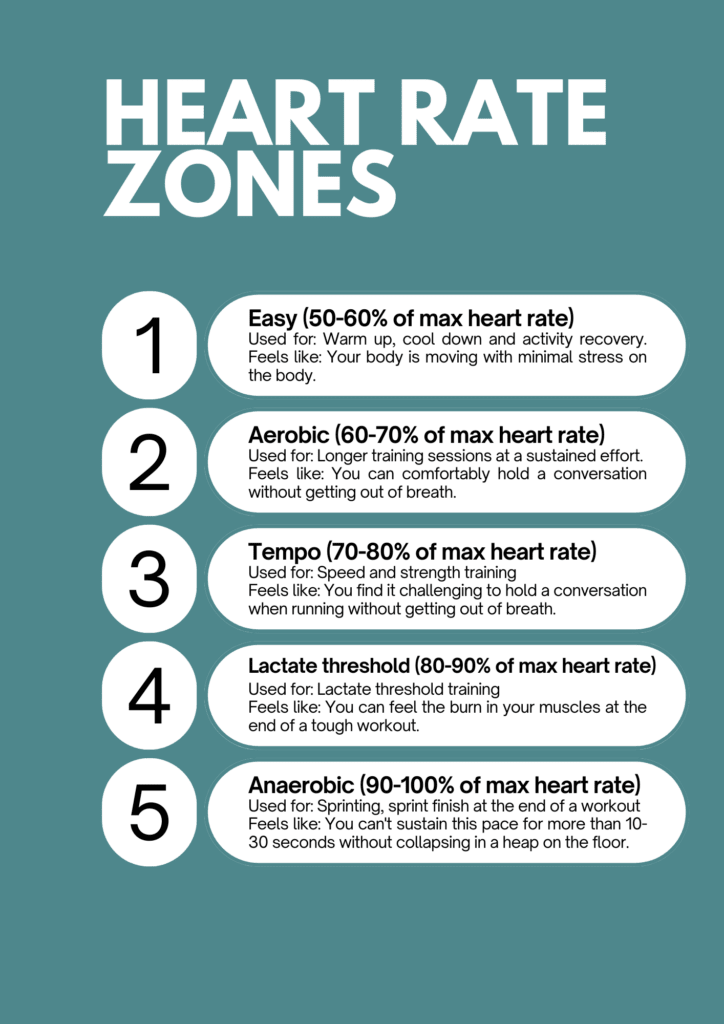You may have heard of pace per mile or VO2 Max as guides for how fast you should run.
Heart rate when running is also a great tool to use to determine how hard you should be working during a run or workout.
Most sports training programmes use the following variables: frequency, duration and intensity.
It’s under intensity where heart rate training comes in.
But if you’re confused about your heart rate and how it should be used during your training, this guide has got you covered!
From understand the different heart rate training zones to monitoring your heart rate when running, I’ll discuss everything you need to know to optimise your training in this guide.
We’ll look at:
- The importance of your heart rate when running
- What are the benefits of heart rate training?
- What are the heart rate training zones?
- Target heart rate vs maximum heart rate (HR Max)
- How to calculate your maximum heart rate
- How to calculate your target heart rate
- What is a high heart rate when running?
- Resting heart rate vs recovery heart rate
- Resting heart rate vs recovery heart rate
- How to monitor your heart rate when running
- 5 ways to lower your heart rate when running
- Sample heart rate training plan
Ready?
Let’s get started!

The importance of your heart rate when running
Your heart rate, or pulse rate, is used to measure workout intensity.
Many athletes use their heart rate and heart rate training zones to help programme their training.
Heart rate is measured in beats per minute (BPM) and can range from 75 bpm to 200 bpm depending on your age, gender and exertion levels.
As your pace and work rate increases, so does your heart rate.
This is so your heart can pump blood to your muscles so they get oxygen to keep going.
Your heart rate is influenced by a number of factors, including your age, gender and fitness levels.
Not all runners have the same heart rate at any given intensity due to physiological differences such as lactate threshold and running economy.
Even factors like medication, caffeine consumption, the weather and how you feel on the day of your run can affect your heart rate.
Running in the heat and humidity and at a high altitude in particular can increase your heart rate.
Your heart rate will also increase as the number of repetitions increase, so it’s worth remembering this when doing intervals, for example.
The bottom line? Leveraging your heart rate when running can lead to better training outcomes.
Related: Running VO2 Max charts: What is good VO2 Max for my age and gender?
What are the benefits of heart rate training?
By using your heart rate when running, you will get a better insight into how your body is responding during training.
Using stats like your heart rate allows you to train smarter, which is always better than training harder.
Here are the primary benefits of heart rate training:
#1 Allows you to work with trackable data
Your heart rate is a piece of data that can be captured and tracked over time.
The importance of this is that you can track progress and improvements made over a set period of time.
It is for this reason that heart rate training is popular with amateur and elite athletes alike.
#2 Optimises your performance
Heart rate training optimises your performance in many ways.
When you track your runs and workouts using your heart rate, you’ll increase your fitness and improve your performance over time and you’ll prioritise recovery time.
A well-rounded training plan will include a range of workouts – some will be easy, some will be tough.
This diversity elevates your training and you can track the intensity in each workout using your heart rate.
Related: 7 essential running form drills for beginners to improve speed and endurance

What are the heart rate training zones?
There are six key heart rate zones that you need to be aware of if you want to leverage heart rate training.
The absolute fastest rate at which your heart is able to beat is zone 5. This is also called the HR Max zone.
The lowest rate is zone 0 which is your resting heart rate.
Your age, gender and fitness levels will determine the heartbeat range for each zone, there is no one size fits all approach.
The chart below shows the six heart rate zones in more detail.
Heart rate training zone chart
| Heart rate zone | % of maximum heart rate | Exertion level | What it feels like… |
| 5 – Anaerobic | 90-100% | Maximum | You feel like you’ll collapse at the end of the run. You can’t sustain this pace for more than 10-30 seconds. |
| 4 – Lactate threshold | 80-90% | Hard | You can feel the burn in your muscles during or at the end of a tough workout. |
| 3 – Tempo | 70-80% | Moderate | You find it more challenging to hold a conversation without getting out of breath. |
| 2 – Aerobic | 60-70% | Light | You can hold a conversation comfortably with your training partner when running. |
| 1 – Easy | 50-60% | Very light | Your body is moving with minimal stress on your body. |
| 0 – Recovery | < 50% | Rest | Rest |

Typically, most runners will train using a variety of heart rate zones using specific workouts.
For example, a workout could look like this:
- Heart rate zone 1 (50-60%) – Warm up for 10 minutes
- Heart rate zone 2 (60-70%) – Easy effort run for 30 minutes
- Heart rate zone 3 (70-80%) – Moderate effort run for 10 minutes
- Heart rate zone 4 (80-90%) – Hard effort run for 6 minutes
- Heart rate zone 5 (90-100%) – Very hard effort run for 2 minutes
- Heart rate zone 1 (50-60%) – Cool down for 10 minutes
If you’re a marathon runner, for example, typically 50-70% of your training will be done in heart rate zones 1 and 2.
Think easy runs and long, continuous runs at a comfortable pace.
Training in heart rate zone 2 in particular allows you to build your endurance and train for sustained periods of time.
Your remaining training will be a combination of heart rate zones 3, 4 and 5.
Think speed training and strength training (zone 3), lactate threshold training (zone 4) and anaerobic training (zone 5).
Training in heart rate zones 3 and 4 allows you to improve your aerobic fitness and muscle strength and increase your lactate threshold.
It also allows you to increase your maximum capacity for shorter, harder efforts.
Whereas training in heart rate zone 5 allows you to develop fast-twitch muscle fibres to boost sprint speed.
If you’re training for a shorter distance like a 5k, you may spend more training time in heart rate zones 3 and 4 to get your body used to running at faster speeds.
The bottom line? A variety of heart training zones will be used in your training.
The exact zones you use will depend on your training and fitness goals.
Related: How to breathe while running: 4 actionable tips

Target heart rate vs maximum heart rate (HR Max)
Your target heart rate is an indicator to tell you if you’re getting maximum benefit from your workout.
The American Heart Association generally recommends a target heart rate of:
- 50-70% of your maximum heart rate for moderate intensity exercise
- 70-85% of your maximum heart rate for vigorous intensity exercise
Your maximum heart rate (also known as HR Max) is the rate at which your heart beats the fastest.
This is during intense periods of your workout such as a sprint finish.
Generally, you’ll only spend about 1-5% of your training in the HR Max zone as it’s physically demanding.
Related: How to increase running stamina and endurance: 6 actionable tips
How to calculate your maximum heart rate
To calculate your maximum heart rate, subtract your age from 220.
For example, if you’re 35 years old, your maximum heart rate will be 185 bpm.
Remember this is just a guide – your actual heart rate may be 15 to 20 bpm higher or lower.
You will need to use a heart rate monitor when running to work out exactly what it is across a series of workouts.
If you do want a more exact calculation, it’s best to do a stress test and then monitor your heart rate.
To do this, do the following workout. You’ll need a heart rate monitor for this:
- Warm up for 15 minutes.
- Run for 1 mile at tempo pace (this should feel comfortably hard).
- Gradually increase your speed over 400m before running a final 400m at an all out pace.
The highest number on your monitor will be close to your maximum heart rate.
Related: 7 of the best running workouts to build endurance, strength and speed

How to calculate your target heart rate
Once you’ve worked out your maximum heart rate, use the table below to determine your target heart rate.
| Age | Target heart rate | Maximum heart rate (HR Max) |
| 20 | 100 – 170 bpm | 200 bpm |
| 30 | 95 – 162 bpm | 190 bpm |
| 35 | 93 – 157 bpm | 185 bpm |
| 40 | 90 – 153 bpm | 180 bpm |
| 45 | 88 – 149 bpm | 175 bpm |
| 50 | 85 – 145 bpm | 170 bpm |
| 60 | 80 – 136 bpm | 160 bpm |
| 70 | 75 – 128 bpm | 150 bpm |
Related: What is a tempo run? 5 tempo run workouts to improve endurance and speed
What is a high heart rate when running?
If you train in a high heart rate zone for too long, this could have negative consequences for your health.
Training in heart rate zones 3, 4 and 5 continuously over consecutive days makes it more difficult for your body to recover after exercise and in between runs.
By doing so you risk overtraining, illness and injury.
This is why it is recommended that you perform 50-70% of your training in heart rate zones 1 and 2 to avoid training burnout.
Related: 14 of the best half marathons in the US

Resting heart rate vs recovery heart rate
Your heart beats faster during exercise, so your heart rate when running is higher than your resting heart rate and recovery heart rate.
Here’s an explanation for each:
- Resting heart rate – the rate your heart beats while you’re doing no activity at all. Typically, it varies between 60 and 100 bpm. You will have a lower resting heart rate if you’re very fit.
- Recovery heart rate – the amount of time it takes for your heart rate to return to its resting heart rate after exercise. As you get fitter, the recovery time will shorten.
Related: 11 things I wish I’d known before running my first 10k
How to monitor your heart rate when running
Monitoring your heart rate when running can help you to avoid overexerting yourself and can lead to better training outcomes.
The best way to monitor your heart rate when running is to use a heart monitor.
Most sports watches nowadays have a heart monitor feature to help you do this.
A heart monitor allows you to track your heart rate throughout your training.
This is important as it allows you to check when your veering outside of your desired heart rate zone so you can slow down or speed up.
Remember your heart rate when running is a tool to guide your training.
Listening to your body is equally as important to ensure you are training at the right intensity level.
Related: The best running watch: Garmin Forerunner 235 review

5 ways to lower your heart rate when running
If you regularly become out of breath on a run, or feel nauseous when running, then you may need to take steps to lower your heart rate.
Here are some training strategies to lower your heart rate:
#1 Slow down your running pace
One of the best ways to lower your heart rate is to slow down your running pace.
Run slowly or speed walk until your heart rate slows down and you can catch your breath.
If you can hold a conversation without getting out of breath, this is a sign you have lowered your heart rate to a safe level.
#2 Take deep breaths
Taking deep breaths helps you to lower your heart rate.
Find a place to sit down and do some deep, diaphragmatic breathing.
Inhale for a count of 4 then exhale for a count of 4 until your heart rate goes back to normal.
#3 Avoid drinking coffee before a run
Caffeine can increase your heart rate and make you dehydrated.
If you do decide to have a coffee before your run, make sure you drink lots of water to balance out its effects.
#4 Pick up the pace gradually
If you’re a new runner, you may be tempted to speed up quickly.
Gradual progression is key when training to beat a time or for a distance goal to avoid overtraining, burnout and injury.
Progression also means you avoid highs in your heart rate.
Related: How to pace your run: 4 simple tips for effective pacing

Sample heart rate training plan
Here is a sample heart rate training plan aimed at intermediate runners.
This training plan is designed to get you used to running in different heart rate training zones.
The idea is that you progress gradually throughout the six weeks of the plan.
So make a note of your heart rate at the start of the plan in week 1 and compare it to your heart rate at the end of week 6.
During each week you can do an optional strength training session on the Saturday but this is completely up to you.
Week 1:
- Monday: Rest day (zone 0)
- Tuesday: 30 minute easy run (zone 2)
- Wednesday: 40 minute easy run (zone 2)
- Thursday: 30 minute easy run (zone 2)
- Friday: Rest day (zone 0)
- Saturday: Rest day (zone 0) or optional strength training session (zone 3)
- Sunday: 60 minute long run (zone 2)
Week 2:
- Monday: Rest day
- Tuesday: 30 minute easy run (zone 2)
- Wednesday: 45 minute easy run (zone 2)
- Thursday: 30 minute easy run (zone 2)
- Friday: Rest day (zone 0)
- Saturday: Rest day (zone 0) or optional strength training session (zone 3)
- Sunday: 70 minute long run (zone 2)
Week 3:
- Monday: Rest day (zone 0)
- Tuesday: 30 minute easy run (zone 2)
- Wednesday: Interval training – 2 x 400m in zone 3, 2 x 400m in zone 4, 2 x 400m in zone 3
- Thursday: 30 minute easy run (zone 2)
- Friday: Rest day (zone 0)
- Saturday: Rest day (zone 0) or optional strength training session (zone 3)
- Sunday: 75 minute long run (zone 2)
Week 4:
- Monday: Rest day (zone 0)
- Tuesday: 30 minute easy run (zone 2)
- Wednesday: Interval training – 2 x 400m in zone 3, 2 x 400m in zone 4, 2 x 400m in zone 3
- Thursday: Tempo run – 10 mins in zone 2, 10 mins in zone 3, 10 mins in zone 2
- Friday: Rest day (zone 0)
- Saturday: Rest day (zone 0) or optional strength training session (zone 3)
- Sunday: 75 minute long run (zone 2)
Week 5:
- Monday: Rest day (zone 0)
- Tuesday: 30 minute easy run (zone 2)
- Wednesday: Interval training – 2 x 400m in zone 3, 2 x 400m in zone 4, 2 x 400m in zone 3
- Thursday: Tempo run – 10 mins in zone 2, 10 mins in zone 3, 10 mins in zone 2
- Friday: Rest day (zone 0)
- Saturday: Rest day (zone 0) or optional strength training session (zone 3)
- Sunday: 80 minute long run (zone 2)
Week 6:
- Monday: Rest day (zone 0)
- Tuesday: 30 minute easy run (zone 2)
- Wednesday: Interval training – 2 x 400m in zone 3, 2 x 400m in zone 4, 2 x 400m in zone 3
- Thursday: Tempo run – 10 mins in zone 2, 15 mins in zone 3, 10 mins in zone 2
- Friday: Rest day (zone 0)
- Saturday: Rest day (zone 0) or optional strength training session (zone 3)
- Sunday: 90 minute long run (zone 2)
- 5 things I wish I’d known before returning to running - March 3, 2024
- Running 20 minutes a day: Benefits + how to start - January 27, 2024
- How to run your first 2 hour half marathon - January 16, 2024
